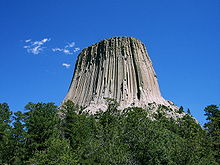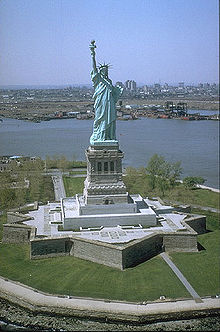- National Monument (United States)
-
A National Monument in the United States is a protected area that is similar to a National Park except that the President of the United States can quickly declare an area of the United States to be a National Monument without the approval of Congress. National monuments receive less funding and afford fewer protections to wildlife than national parks. However, areas within and extending beyond national parks, monuments, and national forests can be part of wilderness areas, which have an even greater degree of protection than a national park would alone, although wilderness areas managed by the United States Forest Service and Bureau of Land Management often allow hunting.
National monuments can be managed by one of several federal agencies: the National Park Service, United States Forest Service, United States Fish and Wildlife Service, or Bureau of Land Management.
The power to grant national monuments comes from the Antiquities Act of 1906. President Theodore Roosevelt used the act to declare Devils Tower in Wyoming as the first national monument. He thought Congress was moving too slowly and it would be ruined by the time they made it a national park.
Contents
History
The Antiquities Act of 1906 resulted from concerns about protecting mostly prehistoric Native American ruins and artifacts (collectively termed "antiquities") on federal lands in the West. The Act authorized permits for legitimate archaeological investigations and penalties for persons taking or destroying antiquities without permission. The Act also authorized presidents to proclaim "historic landmarks, historic and prehistoric structures, and other objects of historic or scientific interest" as national monuments, "the limits of which in all cases shall be confined to the smallest area compatible with the proper care and management of the objects to be protected."
So it was originally expected that national monuments would be proclaimed to protect prehistoric cultural features or antiquities and that they would be small. Yet the reference in the act to "objects of...scientific interest" enabled President Theodore Roosevelt to make a natural geological feature, Devils Tower, Wyoming, the first national monument three months later. Among the next three monuments he proclaimed in 1906 was Petrified Forest in Arizona, another natural feature (Congress later made it into a national park).
The expectation that national monuments would be small was also soon overcome. In 1908, Roosevelt again used the act to proclaim more than 800,000 acres (3,200 km²) of the Grand Canyon as a national monument, a very big "object of scientific interest." And in 1918, President Woodrow Wilson proclaimed Katmai National Monument in Alaska, comprising more than a million acres (4,000 km²). Katmai was later enlarged to nearly 2.8 million acres (11,000 km²) by subsequent Antiquities Act proclamations and for many years was the largest national park system unit. Petrified Forest, Grand Canyon, and Katmai were among the many national monuments later converted to national parks by Congress.
There was no significant Congressional opposition to this expansive use of the Antiquities Act in Arizona and Alaska - perhaps in part because Arizona and Alaska were then only territories without representation in Congress. Substantial opposition did not materialize until 1943, when President Franklin D. Roosevelt proclaimed Jackson Hole National Monument in Wyoming. He did this to accept a donation of lands acquired by John D. Rockefeller, Jr., for addition to Grand Teton National Park after Congress had declined to authorize this park expansion. Roosevelt's proclamation unleashed a storm of criticism about use of the Antiquities Act to circumvent Congress. A bill abolishing Jackson Hole National Monument passed Congress but was vetoed by Roosevelt, and Congressional and court challenges to the proclamation authority were mounted. In 1950, Congress finally incorporated most of the monument into Grand Teton National Park, but the act doing so barred further use of the proclamation authority in Wyoming.
Since 1943, the proclamation authority has been used very sparingly, and seldom without advance Congressional consultation and support. In 1949, for example, President Harry S. Truman proclaimed Effigy Mounds National Monument to accept a donation of the land from the state of Iowa, at the request of Iowa's delegation. On those rare occasions when the proclamation authority was used in seeming defiance of local and congressional sentiment, Congress again retaliated. Just before he left office in 1961, President Dwight D. Eisenhower proclaimed the Chesapeake and Ohio Canal National Monument after Congress had declined to act on related national historical park legislation. The chairman of the House Interior Committee, Wayne Aspinall of Colorado, responded by blocking action on subsequent C & O Canal Park bills to the end of that decade.
The most substantial use of the proclamation authority came in 1978, when President Jimmy Carter proclaimed 15 new national monuments in Alaska after Congress had adjourned without passing a major Alaska lands bill strongly opposed in that state. Congress passed a revised version of the bill in 1980 incorporating most of these national monuments into national parks and preserves, but the act also curtailed further use of the proclamation authority in Alaska.
The proclamation authority was not used again anywhere until 1996, when President Bill Clinton proclaimed the Grand Staircase-Escalante National Monument in Utah. This action was widely unpopular in Utah, and bills were introduced to further restrict the president's authority. To date, none of them have been enacted. Most of the 16 national monuments created by President Clinton are managed not by the National Park Service, but by the Bureau of Land Management as part of the National Landscape Conservation System. New Monuments managed by the Park Service are Governors Island National Monument, Virgin Islands Coral Reef National Monument, and, formerly, Minidoka Internment National Monument (since 2008: Minidoka National Historic Site).
George W. Bush proclaimed two very different monuments in 2006, the hundredth anniversary of the Antiquities Act. African Burial Ground National Monument is a tiny archeological site in New York City. Northwestern Hawaiian Islands National Monument protects roughly 140,000 square miles (360,000 km²) of the Pacific Ocean, larger than all of America's national parks combined.[1] (It was renamed Papahānaumokuākea Marine National Monument in 2007).
Presidents have used the Antiquities Act's proclamation authority not only to create new national monuments but to enlarge existing ones. For example, Franklin D. Roosevelt significantly enlarged Dinosaur National Monument in 1938, Lyndon B. Johnson added Ellis Island to Statue of Liberty National Monument in 1965, and Jimmy Carter made major additions to Glacier Bay and Katmai National Monuments in 1978.
In January 2009, President George W. Bush used the Antiquities Act to create the Mariana Trench Marine National Monument, the Pacific Remote Islands Marine National Monument, and the Rose Atoll Marine National Monument.
List of National Monuments
Main article: List of National Monuments of the United StatesSee also
- List of U.S. National Forests
- List of areas in the National Park System of the United States (includes list of NPS-managed National Monuments)
- List of U.S. wilderness areas
- List of miscellaneous U.S. public areas
References
- ^ Joshua Reichert and Theodore Roosevelt IV. "Treasure Islands". http://www.pewtrusts.org/ideas/ideas_item.cfm?content_item_id=3417&content_type_id=15&page=15&issue=16&issue_name=Protecting%20ocean%20life&name=Op-eds%20(Pew). Retrieved June 15, 2006.
External links
- National Monument Proclamations under the Antiquities Act (public domain text)
- Congressional Research Service (CRS) Reports regarding National Monuments
U.S. National Register of Historic Places Topics Lists by states Alabama • Alaska • Arizona • Arkansas • California • Colorado • Connecticut • Delaware • Florida • Georgia • Hawaii • Idaho • Illinois • Indiana • Iowa • Kansas • Kentucky • Louisiana • Maine • Maryland • Massachusetts • Michigan • Minnesota • Mississippi • Missouri • Montana • Nebraska • Nevada • New Hampshire • New Jersey • New Mexico • New York • North Carolina • North Dakota • Ohio • Oklahoma • Oregon • Pennsylvania • Rhode Island • South Carolina • South Dakota • Tennessee • Texas • Utah • Vermont • Virginia • Washington • West Virginia • Wisconsin • WyomingLists by territories Lists by associated states Other Categories:- National Monuments of the United States
- Protected areas of the United States
Wikimedia Foundation. 2010.





